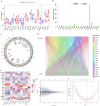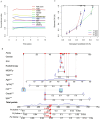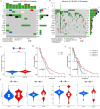A novel cuproptosis-associated LncRNA model predicting prognostic and immunotherapy response for glioma
- PMID: 40512434
- PMCID: PMC12165929
- DOI: 10.1007/s12672-025-02912-6
A novel cuproptosis-associated LncRNA model predicting prognostic and immunotherapy response for glioma
Abstract
Recent studies have identified cuproptosis as a novel form of regulated cell death (RCD), and long non-coding RNAs (lncRNAs) have been implicated in glioma progression and prognosis. However, the role of cuproptosis-associated lncRNAs in gliomas has not been systematically assessed. In this study, data from the Cancer Genome Atlas (TCGA) and the Chinese Glioma Genome Atlas (CGGA) databases were used, and cuproptosis-related genes were obtained from previous research. Cuproptosis-associated lncRNAs were identified through co-expression network analysis, Cox regression, and Least Absolute Shrinkage and Selection Operator (LASSO). A total of 10 cuproptosis-associated lncRNAs were selected to construct a prognostic prediction model. The high-risk group was associated with poor overall survival (OS) and progression-free survival (PFS). Multivariate Cox regression, Receiver Operating Characteristic (ROC) curve analysis, C-index, and nomogram demonstrated the accuracy of the 10-lncRNA signature in predicting outcomes in glioma patients. Gene Ontology (GO), Kyoto Encyclopedia of Genes and Genomes (KEGG), and Gene Set Variation Analysis (GSVA) enrichment analyses revealed a strong association between the signature and immune response pathways. Immune cell infiltration and Single-Sample Gene Set Enrichment Analysis (ssGSEA) further confirmed that the signature is closely linked to immune responses in glioma patients. Further investigation revealed significant differences in tumor immune dysfunction and rejection (TIDE) scores and half-maximal inhibitory concentration (IC50) values for many drugs between low- and high-risk subgroups. This risk signature may serve as a prognostic tool and offer valuable insights into treatment strategies for glioma patients. Additionally, the expression levels of the 10 signature genes were validated by quantitative real-time polymerase chain reaction (qRT-PCR).
Supplementary Information: The online version contains supplementary material available at 10.1007/s12672-025-02912-6.
Keywords: Cuproptosis; Glioma; Immune microenvironment; LncRNA; Prognosis.
Conflict of interest statement
Declarations. Ethics approval and consent to participate: This study was approved by the Ethics Committee of Guizhou Provincial People’s Hospital. All procedures performed in this study involving human participants were in accordance with the ethical standards of the institutional research committee and with the 1964 Helsinki Declaration and its later amendments. Consent to publish: All patients provided consent for publication of anonymized data related to this study. Competing interests: The authors declare no competing interests. Informed consent: Written informed consent was obtained from all patients involved in the study.
Figures








Similar articles
-
A Cuproptosis-Related LncRNA Risk Model for Predicting Prognosis and Immunotherapeutic Efficacy in Patients with Hepatocellular Carcinoma.Biochem Genet. 2024 Jun;62(3):2332-2351. doi: 10.1007/s10528-023-10539-x. Epub 2023 Oct 29. Biochem Genet. 2024. PMID: 37898914
-
Cuproptosis facilitates immune activation but promotes immune escape, and a machine learning-based cuproptosis-related signature is identified for predicting prognosis and immunotherapy response of gliomas.CNS Neurosci Ther. 2024 Feb;30(2):e14380. doi: 10.1111/cns.14380. Epub 2023 Jul 28. CNS Neurosci Ther. 2024. PMID: 37515314 Free PMC article.
-
A novel defined risk signature of cuproptosis-related long non-coding RNA for predicting prognosis, immune infiltration, and immunotherapy response in lung adenocarcinoma.Front Pharmacol. 2023 Aug 21;14:1146840. doi: 10.3389/fphar.2023.1146840. eCollection 2023. Front Pharmacol. 2023. PMID: 37670938 Free PMC article.
-
A cuproptosis-related lncRNA signature for predicting prognosis and immune response in hepatocellular carcinoma.Heliyon. 2023 Aug 29;9(9):e19352. doi: 10.1016/j.heliyon.2023.e19352. eCollection 2023 Sep. Heliyon. 2023. PMID: 37810122 Free PMC article.
-
Identification of cuproptosis-related lncRNAs for prognosis and immunotherapy in glioma.J Cell Mol Med. 2022 Dec;26(23):5820-5831. doi: 10.1111/jcmm.17603. Epub 2022 Nov 1. J Cell Mol Med. 2022. PMID: 36317420 Free PMC article.
References
-
- Ostrom QT, Price M, Neff C, Cioffi G, Waite KA, Kruchko C, Barnholtz-Sloan JS. CBTRUS statistical report: primary brain and other central nervous system tumors diagnosed in the united States in 2015–2019. Neuro Oncol. 2022;24(Supplement5):v1–95. 10.1093/neuonc/noac202. PMID: 36196752; PMCID: PMC9533228. - PMC - PubMed
-
- Komori T. Grading of adult diffuse gliomas according to the 2021 WHO classification of tumors of the central nervous system. Lab Invest. 2022;102(2):126–33. 10.1038/s41374-021-00667-6. PMID: 34504304. - PubMed
-
- Chen J, Han P, Dahiya S. Glioblastoma: Changing concepts in the WHO CNS5 classification. Indian J Pathol Microbiol. 2022;65(Supplement):S24–32. 10.4103/ijpm.ijpm_1109_21. PMID: 35562131. - PubMed
LinkOut - more resources
Full Text Sources
